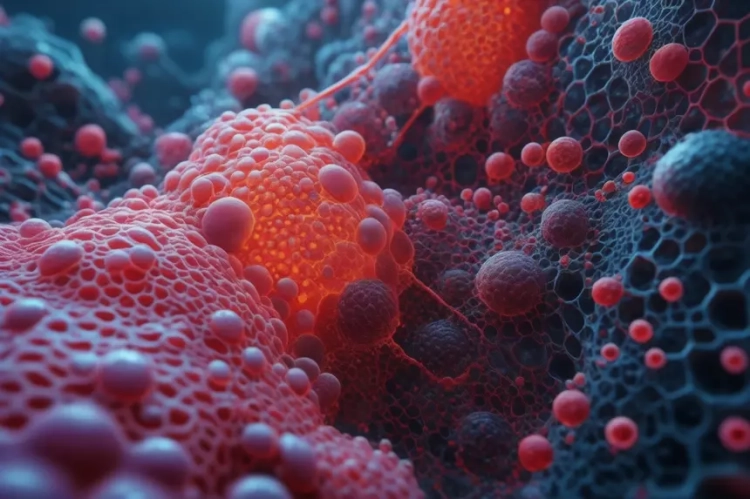
SAPONIN-CONTAINING PLANTS
Among the many useful plants of Kyrgyzstan, there are those that contain saponins.
Currently, saponins are widely used in various industries, medicine, and veterinary medicine. The demand for saponins in the USSR is increasing year by year — they are necessary for both domestic needs and foreign trade. Therefore, the identification and study of saponin-containing plants is becoming particularly important at this time.
As is known, saponins are complex compounds and are polyglucosides of steroid or triterpene aglycones.
These are toxic amorphous substances of colorless or yellowish hue, often with a bitter taste.
Saponins are widely used in medicine for the treatment of radiation sickness, atherosclerosis, eczema, rheumatism, and other diseases. They possess antihelminthic properties and are used to combat helminths (worms). Saponins are also used to produce hormonal drugs.
In veterinary medicine, saponins are used to prepare vaccines and to combat parasitic worms.
Saponins act on hematopoietic organs and the nervous system. They increase the permeability of cells in various tissues, promote the secretion of urine, saliva, and sweat; suppress the activity of some viruses and lower plants, and can cause hemolysis of red blood cells.
Under the influence of saponins, as noted by many scientists, the action of medicinal substances is accelerated, and the activity of certain enzymes increases.
Saponins also affect cell growth. In some cases, they stimulate growth, while in others, they slow it down.
Thus, saponins have a stimulating, tonic, antispasmodic, and hypotensive effect.
Saponins are of great importance in the construction, chemical, mining, and light industries.
The foaming property of saponin-containing plants is used for the production of building materials, which leads to a reduction in the cost of concrete.
The foaming property of saponins is also used in confectionery production, as well as in the mining industry during ore enrichment, and in the fur industry for cleaning furs.
Saponin-containing plants are interesting from a theoretical point of view. Understanding their systematics, geography, ecology, and biology can reveal the patterns of accumulation of plastic substances by plants. Their study is also necessary to clarify issues of the phylogenesis of flowering plants. Data on saponin-containing plants are important for botanical biogeography.
The study of wild saponin-containing plants in Kyrgyzstan contributes to the development of scientific foundations for their introduction and methods of rational use.
It should be noted that the saponin flora of Kyrgyzstan is still poorly studied. Research on saponin-containing plants in Kyrgyzstan began only in 1960, mainly by the workers of pharmacognosy at the Academy of Sciences of the Kyrgyz SSR. They studied the chemistry of individual saponin-containing plants. Significant work in this direction was done by P. K. Alimbaeva, S. T. Kholodkov, A. V. Matveeva, A. V. Goncharova (1971), and others.
In 1970, the Department of Botany of the Biological Faculty of Kyrgyz State University began studying saponin-containing plants.
Members of the department conducted expeditions to various regions of the Central Tien Shan, the Issyk-Kul basin, Talas, Chatkal, and the Chui valley. During the expeditions, the flora of these regions was studied. Approximately 1,000 species of plants were selected for analysis of their saponin content. Analyses were conducted in collaboration with the Institute of Organic Chemistry of the Academy of Sciences of the Kyrgyz SSR and separately at the Department of Botany.
A physical method was used to determine saponins. It is based on the fact that aqueous solutions of saponins (with the addition of certain substances) form foam when shaken. In total, as mentioned, 1,000 collected species of plants were analyzed.
The conducted analyses showed that the largest number of saponin-containing plants belong to the families Asteraceae, Amaryllidaceae, Caryophyllaceae, Primulaceae, Ranunculaceae, Brassicaceae, Fabaceae, Lamiaceae, Scrophulariaceae, Boraginaceae, Papaveraceae, Gentianaceae, Apiaceae, Chenopodiaceae, and Solanaceae. Other families contained fewer saponin-containing plants. However, it should be noted that not all species of the mentioned families were subjected to analysis. When using saponin-containing plants found in Kyrgyzstan, attention should primarily be paid to the aforementioned families.
It is important to emphasize that a number of saponin-containing plants in Kyrgyzstan, although they contain a sufficient amount of saponins, are not economically viable for industrial extraction for various reasons. Some of them, such as Ephedra and Patrinia, are anti-erosion and medicinal plants, and are significant for stabilizing slopes. Others, like sea buckthorn, are water-regulating and water-protecting, and besides, they contain valuable fruits that are important in medicine.
However, among saponin-containing plants, there are also weeds. The extraction of saponins from them would be quite promising, as the raw material for processing would consist of weeds collected as a result of cleaning fields, gardens, and pastures.
Below is a brief description of the most important species of saponin-containing plants in Kyrgyzstan.

Blue hairy plant, from the family Boraginaceae. This is a powerful plant up to 140 cm tall with a rosette of lanceolate leaves at the base.
The flowers are bright blue, collected in spherical heads. The bracts are prickly, which is why they are commonly called hairy cones. It blooms in July and bears fruit in August-September.
It grows in steppes and meadow-steppes, among steppe shrubs. It is characteristic of Southern and Southwestern Kyrgyzstan — Fergana, Alai ridges, as well as for the Kyrgyz Ala-Too. It infests grassland pastures, as it is not eaten by livestock. However, it is a valuable plant as it contains saponins (-f -f -f-) and alkaloids.
The raw material reserves of the hairy plant are enormous.
Bellflower. A perennial plant up to 40 cm tall, widely distributed in high mountain steppes, meadow-steppes, and even meadow pastures (in cobrezia meadows).
The leaves are elongated-oval. The flowers are bell-shaped, blue-purple, large, up to 27 mm long. The fruits have long awns — up to 3 cm. It is especially characteristic of the Inner Tien Shan, Chatkal, Talas, Fergana, Alai, Kyrgyz Ala-Too. It is also found in the Issyk-Kul basin.
Although livestock, especially sheep, willingly eat the flowers and fruits of the bellflower, cases of poisoning are observed, especially when animals consume it in large quantities.
The bellflower contains saponins (+ + +). Its use for the extraction of saponins will help to clean pastures from this weedy and partly toxic plant.
True yellow bedstraw. Widely distributed in the steppes of Kyrgyzstan. It can be found in the Kyrgyz ridge, in Susamyr, in the Issyk-Kul basin.
This perennial plant has many branches that bear large paniculate inflorescences with bright yellow small flowers. The leaves are thread-like and linear, arranged in whorls. It blooms in June-July and bears fruit in July-August. It contains saponins (+ -(- +). It is not eaten by livestock and is considered a weed of pastures. The raw material reserves are enormous. It is advisable to investigate other species of this genus for their saponin content.

North bedstraw, differs from the previous species by its white flowers. A perennial plant, up to 70 cm tall. The leaves are lanceolate, arranged in whorls. The flower cluster is spreading.
It grows in forest clearings, among shrubs, in forests in almost all regions of Kyrgyzstan.
Saponin content (+ + +).

Sogdian eremurus, a beautiful wild decorative perennial plant with a huge conical cluster of white-greenish flowers, and a rosette of narrow-linear leaves at the base.
It grows in foothills and mid-mountains, in steppes and semi-deserts. It blooms in June and bears fruit in July.
It contains saponins (+ -f -f).
Saponins have also been found in Regel's eremurus (+ -f- +).
It is necessary to study other species of this genus. The raw material reserves of eremurus in Kyrgyzstan are enormous. In June, almost all the foothills of Southwestern Kyrgyzstan are covered with these amazing plants.
In recent years, eremurus has proliferated significantly, as they are poorly consumed by livestock. Livestock only eat the leaves in spring. Considering this, the extraction of saponins should primarily be conducted from eremurus.
Analyses have shown that in the family Amaryllidaceae, besides eremurus, various onions — both wild and cultivated — contain saponins. Onion contains saponins (+ + -|-).

Afghanistan onion. The tallest onion. Its stems reach up to 150 cm in height. The bulb is large, 2-6 cm thick with paper-like outer sheaths. The leaves are linear and flat, shorter than the stem. The umbel is spherical. The flowers are purple.
It grows in tall grass meadows. It is particularly characteristic of the southwestern part of the Inner Tien Shan and Fergana.
It is very effective during flowering. Saponin content (+ + +).

Black-purple onion. A mountain onion with elongated-oval bulbs attached to the rhizome. The stems are 10-40 cm tall. The leaves are tubular. The flowers are black-purple-violet. The umbel is dense, with many flowers.
It grows near springs, in river valleys, sometimes on stony slopes in the high mountain belt. It is especially characteristic of the subalpine meadows of the Inner Tien Shan, Chatkal, Fergana, Alai, and Kyrgyz ridge.
A fodder plant, it is eaten by sheep. It can also be consumed by humans. It is decorative. Saponin content ( + + + ).

Mountain-loving onion. The bulb has gray paper-like sheaths. The stem is 20-25 cm tall. The leaves are linear.
The umbel is hemispherical. The flowers are purple-pink.
It grows in the subalpine and alpine belts of the mountains on stony-sloped areas in Central Tien Shan, Alai, Fergana, Talas, in the Kyrgyz Ala-Too. Saponin content (-р -р -р).

Pallas's onion. The bulb has gray paper-like sheaths 1-2 cm thick. The stem is up to 75 cm tall, half-covered by leaf sheaths. The leaves are narrow-linear. The flowers are pink with a dark vein. The umbel is multi-flowered.
It grows in dry stony places, from the foothills to the alpine belt of the mountains in almost all regions of Kyrgyzstan. Saponin content (+ -р +).
Blue-blue onion. The bulb is oval, up to 1.5 cm in diameter. The outer sheaths are dense and gray. The stems are thin.
The leaves are semi-cylindrical. The flowers are blue-blue. The umbel is spherical.
It is found in the steppes from the foothills to the upper mountain belt, in almost all regions of Kyrgyzstan. Saponin content (+ -|—р).
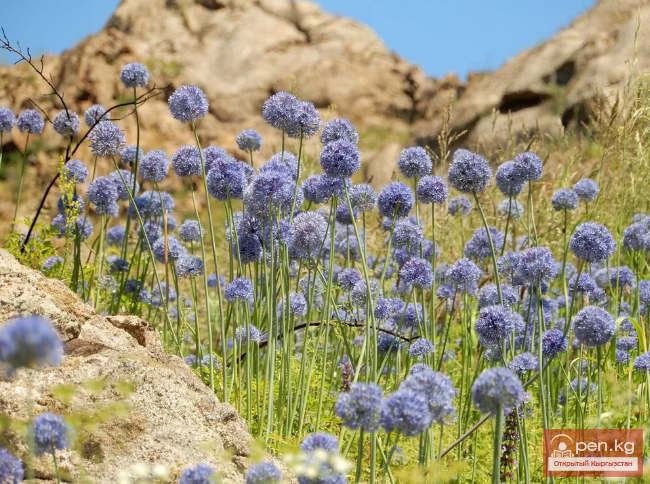
Blue onion. The bulb is 1-2 cm thick, spherical, covered with paper-like gray sheaths. The leaves are three-angled. The stems are up to 90 cm tall. The flowers are blue. The inflorescence is a multi-flowered umbel.
It grows in tall grass meadows, in meadow-steppes, in low and mid-mountain areas in the Inner Tien Shan, Chatkal, and Kyrgyz ridge. It is edible. It can replace onion. Saponin content (+ -р +).
Saponins have been found in the family Amaryllidaceae in tulips.
Greig's tulip. The most beautiful spring decorative plant. The bulb is oval with thin brown sheaths. The stem is up to 50 cm tall. The leaves have purple-purple spots.
The flower is very large, up to 18 cm in diameter, solitary. The tepals are orange-red with a black spot at the base. It blooms in April-May.
It grows in fallow lands and on fields and steppes, in the Chui valley, in Talas, Chatkal, Kyrgyz ridge, and in the Small and Large Kemin. It contains saponins (+ +

Helzer's carnation. Externally resembles the cultivated garden carnation. The flowers are pink and dark pink. It blooms from June to August and bears fruit in July-August.
It is found in tall grass meadows, in forest clearings, among shrubs, almost in all regions of Kyrgyzstan, but does not form large thickets. The most typical meadow areas with its presence are found in Susamyr, in the Zhangaiz-Tol gorge, Chaar-Tash, Kerege-Tash, Baltemir-Bulak, Suyek, Ala-Archa, and Sokuluk.
Saponin content (+ -+- +).
In folk medicine, it is used as a hemostatic and uterine remedy.
In the past, a decoction of carnation was used for bites from rabid animals.
The multicolored carnation grows in steppes and meadow-steppes. It also contains saponins (+ + +).
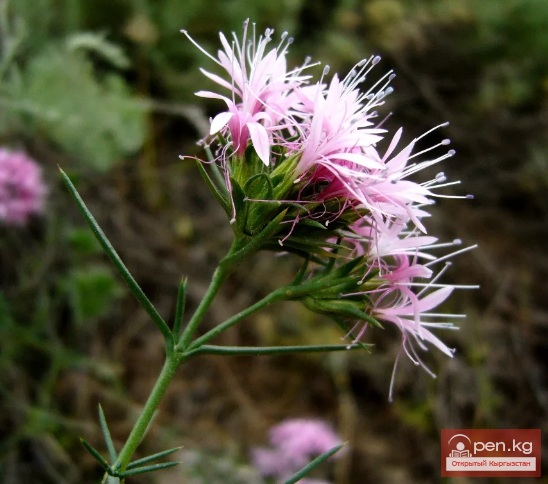
Spiny thistle. A perennial plant with a well-developed root and highly branched stems, reaching up to 80 cm in height. Sometimes the stems have a purple color. The leaves are opposite, sharp, and spiny.
The flowers are white-pink, located at the top of the stems in the form of a paniculate inflorescence.
It grows in deserts and steppes, in the Chui and Talas valleys. The raw material reserves are quite limited. It contains a high percentage of saponins (+ + +).
Analyses have shown that some representatives of the Primulaceae family contain significant amounts of saponins, such as cortusa, primrose, and others.
Medium Patrinia. A perennial herbaceous plant with a large multi-headed rhizome and a taproot.
The stems reach up to 70 cm in height. The leaves are opposite. The flowers are yellow in shield-like paniculate inflorescences. It blooms in June-July.
It grows on rocky slopes, in the floodplains of mountain rivers, predominantly in steppe and forest-meadow zones, almost throughout the republic.
It has long been used as a pain-relieving, bactericidal, and antiseptic agent.
Saponin content (+ + +).
Black nightshade. A weedy, annual herb with white flowers.
It grows in gardens and vegetable plots, near housing, in garbage dumps, in crops, and in thickets of shrubs.
Saponin content (+ -+- +).
The extraction of saponin from nightshade is quite profitable, as raw materials can be obtained by cleaning fields, gardens, and vegetable plots of this weed.
It should be noted that saponins have also been found in tomato seeds and potato tops (I—|- +). Thus, potato tops and tomato seeds can also serve as a good source of raw materials for saponin extraction.

Creeping kochia. A desert semi-shrub containing saponins (+ + +). It is described in the section "Fodder plants".

Eastern clematis. A liana-like perennial plant with beautiful finely dissected leaves and fluffy fruits. The flowers are located in paniculate inflorescences. The perianth is simple. The tepals are yellowish on the inside and reddish on the outside. It blooms from June to August.
It grows along riverbanks, among shrubs, on gravel beds almost throughout Kyrgyzstan.
Saponin content (+ + +).
Besides saponins, it contains other substances. It is toxic to animals. In folk medicine, it is used for syphilitic lesions of the nose. The flowers and fruits are used in the treatment of purulent bone diseases.
It is decorative before blooming and especially during fruiting.
Creeping anchor plants. A peculiar, creeping plant. The stems are up to 60 cm long, branched, sprawling. The leaves are pinnate with sharp stipules. The flowers are yellow, small, axillary. It blooms in April-May and later, bearing fruit in June-July.
It grows as a weed by roads, in wastelands, in crops. Saponin content (+ + +).
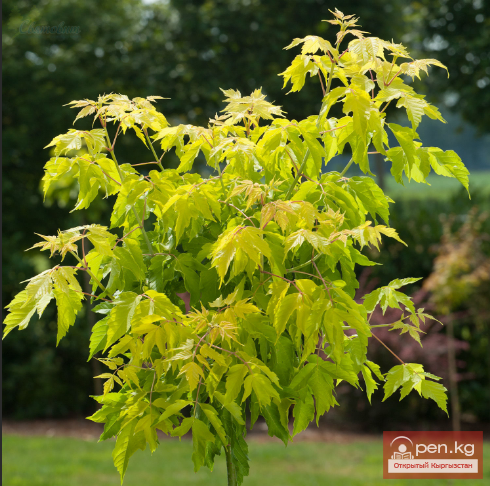
Maple with ash-like leaves, green. A cultivated decorative tree up to 15 cm high with gray bark. The leaves are odd-pinnate or trifoliate. Female flowers are in hanging inflorescences. The fruits are samaras. It blooms in May and bears fruit in August. It is used as an ornamental plant in gardens and parks. Saponin content (+ + +).
Burdock with naked seeds. A biennial plant with a taproot. The stem reaches 120-160 cm in height, branched. The leaves are large with a heart-shaped base. The inflorescence is a basket. The flowers are purple.
It grows in garbage places near housing, in forest protective strips, in groves, near roads, in parks.
Saponin content (+ + +).
Late wormwood. (Described in the section "Fodder plants"). Saponin content (+ + +).
When extracting saponins from it, one should avoid specimens affected by fungi, broomrape, and dodder.

Bitter wormwood. A powerful perennial plant. The stems reach 150 cm in height. The leaves are twice pinnately dissected.
The flowers are yellowish. The inflorescence is a spherical basket.
It grows in meadow-steppes and steppes. It is often found near irrigation ditches and rivers, near crops, and sometimes forms significant thickets in fallow lands.
Saponin content (+ + +).
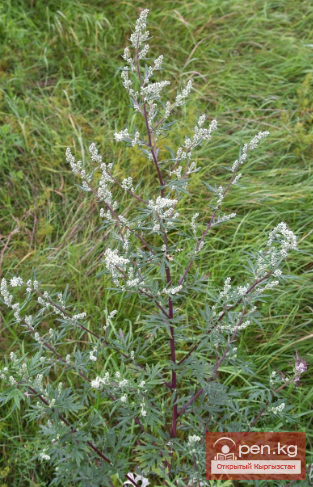
Common wormwood, in Kyrgyz "kuuray." A weedy perennial herbaceous plant up to 180 cm tall. The stems are erect, woody at the bottom. The leaves are pinnately dissected. The flowers are pink, collected in baskets. It blooms from June to October and bears fruit in September.
It grows everywhere in Kyrgyzstan in weedy places, wastelands, riverbanks, streams, in agricultural zones.
In folk medicine, it is used to treat rheumatism, malaria, and stomach diseases.
Saponin content (+ + +).
German iris, "petushki." A well-known perennial plant, rhizomatous, decorative, with fairly tall (up to 80 cm) stems. The leaves are wide-linear. The flowers vary in color — from light blue to variegated, very large, fragrant. There are many varieties with blue and purple flowers, and some varieties have a dirty purple color.
It blooms in April-May.
It is grown in flower beds as an early flowering plant.
Saponin content (+ + +).
In general, when extracting saponins, it is advisable to primarily use weedy species of saponin-containing plants.
Their use can bring double benefits: the extraction of saponins and the removal of weeds from fields, gardens, and pastures.
The use of saponin-containing plants should be approached with great caution. In nature, they perform anti-erosion and water protection functions. Their thoughtless use can disrupt the natural balance and lead to undesirable processes in natural complexes.











































